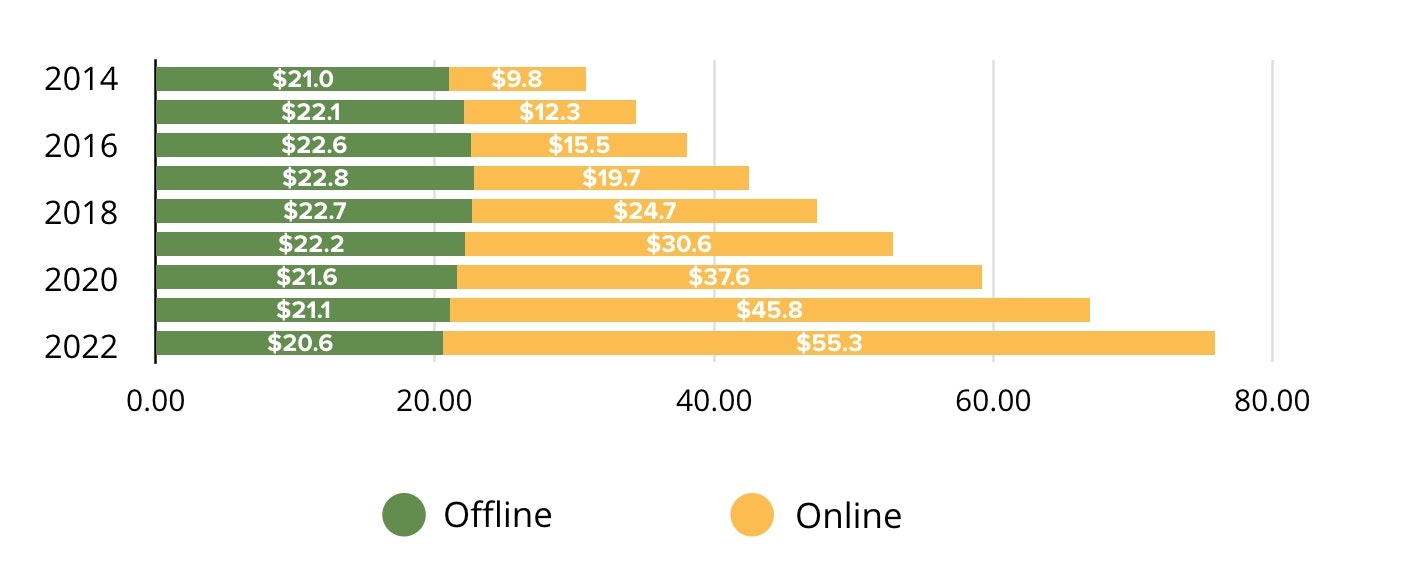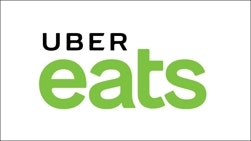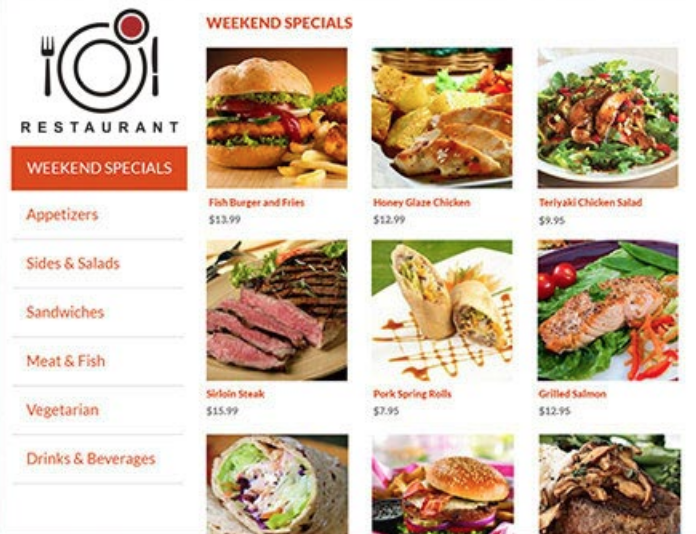Why You Need to Take Your Restaurant Food Ordering In-House
There has never been a better time to get into the online food ordering and delivery business as a small restaurant business owner.
Consumers’ appetite for online food delivery is on the rise, according to recent market research.
In a survey by Morgan Stanley, which included nearly 6,000 customers, 47 percent had their food delivered over a six-month period in 2017, compared to 44 percent in the previous year.
Similarly, food delivery sales have grown 20 percent while the overall number of deliveries increased 10 percent over the last five years, according to the NPD Group.
Investment firm Cowen Group is bullish about the online food delivery space, predicting a 79 percent spike from $43 billion in 2017 to $75.9 billion in 2022—or 12 percent growth annually—in the total U.S. food delivery market.
U.S. Restaurant Delivery Revenues (2014-2022), in the billions (Source)
(Source)
All signs point toward an influx of sales (and profits) for restaurants in the online ordering-delivery business. But for restaurants using third-party ordering apps such as GrubHub, Uber Eats, Postmates and DoorDash as their primary means of delivering orders, that could not be further from the truth.
Restaurants are signing up with third-party providers as a way to gain exposure and reach new customers. But as they continue to rely on third-parties—and as commission fees grow alongside increasing food orders—restaurants are forfeiting a significant chunk of their revenue and hurting their bottom line, instead of growing their business.
Restaurants must take advantage of in-house food ordering systems to avoid high third-party commission fees. In doing so, they can increase their profitability by as much as 35 percent.
Here’s what we’ll cover:
3 Reasons You Should Rethink Third-Party Food Ordering
Benefits of In-House Food Ordering Services
3 Reasons You Should Rethink Third-Party Food Ordering
Pizza and Chinese restaurants used to be the dominant players in the delivery business. Today, everyone’s favorite mom and pop store is embracing the practice.
Driven by fast-growing consumer demand, third-party online food ordering services such as GrubHub, Uber Eats, Postmates and DoorDash are becoming a staple for restaurants looking to attract new customers.
The economics of third-party food ordering delivery is simple: These platforms serve as aggregators for restaurants within a vicinity, process food orders, manage transactions and, where needed, handle deliveries as well.
And while third-parties do not actually make the food, they work with local restaurants to reach customers who are looking for a fast and convenient way to eat without actually having to travel to these locations.
1. Hefty Commission Fees Take a Chunk of Your Business
In exchange for their services, restaurants have to pay third-parties some form of commission and fees. Here’s what two key players are charging:

WHAT IT CHARGES: GrubHub charges an average of 18 percent commission across its entire network of over 80,000 restaurants.
According to a spokesperson from the company, the commission rate for restaurants that handle their own delivery can be as low as 15 percent, while restaurants that require its delivery services can expect to pay a total percentage “in the high 20s.”
The same commission rate applies across GrubHub’s entire portfolio which consists of Seamless, Eat24, AllMenus and MenuPages. (Seamless and GrubHub merged in 2013, and in 2017, the latter went on to acquire Yelp’s Eat24 for $288 million.)
Asked how much more the commission rate for a sponsored listing is, GrubHub says: “As each restaurant’s account advisor works to find a tailored, negotiable commission rate, there isn’t a standard, additional percentage to call out for a sponsored listing.”

WHAT IT COVERS: The company works with restaurants in two ways: It processes orders for restaurants that manage their own delivery; it can also manage orders and provide delivery for restaurants that require both services.
WHAT IT CHARGES: Uber Eats charges as high as 35 percent in commission for every order “which is calculated as a percentage of sales.”
WHAT IT PROVIDES: The platform offers two pieces of software to restaurant partners—the Restaurant Dashboard, which runs on a tablet in the restaurant, and Restaurant Manager, a web-based tool for restaurant managers to view analytics.
The delivery platform promotes the restaurant’s menu on its app and website. Once an order is received, a delivery partner picks up the meal and delivers it. “Depending on city, customer demand and cuisine type,” Uber Eats claims its top restaurant partners generate over $6,400 a month (according to data from August 2016).
2. Third-Party Delivery Does Not Deliver Scalability
A majority of restaurant owners are willing to part with a percentage of their sales in exchange for acquiring new customers in the early days of their business—and understandably so.
However, most operate on already thin margins of around 10-20 percent. By paying per-order commission fees for customers and repeat customers, they soon realize how hard it is to build sustainable growth for their restaurants in the long run.
See what third-party vendors are costing some of these restaurant partners:
Mulberry & Vine. “We know for a fact that as delivery increases, our profitability decreases,” says Michelle Gauthier, owner of the American restaurant with five branches across Manhattan, New York. By her estimates, between 20 and 40 percent of the restaurant’s revenue goes to third-party platforms and couriers.
Luz. “The more business we bring Seamless, the more commission they charge us,” says owner Pedro Munoz of the Latin-American restaurant in Brooklyn, New York.
Veselka. “We don’t have the capacity to really analyze the economics of it carefully. We’re in the dark,” says Tom Birchard, owner of the popular Ukrainian restaurant, which uses services such as DoorDash, Caviar and GrubHub.
Endless Summer Taco. Two years after signing up for third-party online delivery services, Teddy Roland, owner of the Endless Summer Taco food truck, says: “My little family shop started looking like a Sprint store.” His delivery partners typically took a cut of 20 percent or more.
Why Domino’s, Olive Garden and Habit Restaurants won’t be working with third-parties anytime soon:
Domino’s is taking a strong position against outsourcing its deliveries. Its CEO Patrick Doyle told analysts earlier this year: “The efficiency of the delivery process is something we know and understand very, very well. That’s not something you’re ever going to see us outsource. The only way to bring a long-term competitive advantage is to do it yourself.”
Gene Lee, CEO of Darden Restaurants, which owns Olive Garden, says the restaurant is “not going to live with the economics that some of the [third-party] players are asking for.” He adds: “At the end of the day, we’re testing and we’re being diligent, but we’re not willing to give up 20 to 25 percent just to get a sale.”
Russell Bendel, CEO and president of burger chain Habit Restaurants, remains unconvinced about working with third-party vendors. “We’ve met with all of the third-party delivery companies,” he says. “People want convenience, but we’re not willing to give 30-plus percent of proceeds to a third-party delivery company.”
3. You’re Losing More Than You Think With Third-Party Delivery: Calculate the Cost
We know that the average commission fee restaurants pay to third-party vendors ranges from 15-35 percent. This means the more business your restaurant generates, a higher percentage of your sales—which can cost thousands of dollars per month—goes straight into the pockets of third-parties.
If you’re working with third-party vendors, more business doesn’t necessarily make you more money.
For restaurant owners, these fees can add up quickly. You’ve already got your plate full with expenses to pay such as the cost of food, rent, salaries of your cooks and waiters etc. When all that’s said and done, a 15 percent commission rate on top of escalating expenses becomes a lot more problematic.
We’ve come up with a calculator to help determine how much you could be losing by using third-party restaurant food delivery systems. You can also look at the results and consider how much more your potential earnings could be by performing delivery services in-house.
Our equation can also be applied manually. To calculate how much you’re losing each month with third-party platforms:
Take the value of your monthly revenue and multiply that by 25 percent (the average percentage of commission fees) and you’ll arrive at how much money you could be losing each month—or potentially profiting.
Benefits of In-House Food Ordering Systems
We’ve discussed how using third-party platforms can be risky for restaurant owners who are barely squeaking by on single digit profit margins.
Switching to an in-house ordering system guarantees that you’ll retain a majority of revenue from your food orders and avoid losing large profit percentages to the middlemen. Beyond no longer having to pay these inflated fees, here are a few more benefits from bringing your online food ordering in-house.
1. Increased Customer Loyalty
Many restaurants are willing to risk their already low profit margins to third-party apps in hopes that it will bring them new customers that will become loyal.
But the opposite often happens. Once a customer completes an order, the challenge lies in driving brand loyalty. Because restaurants don’t actually own the customers, customer loyalty often shifts to the third-party platforms.
Mark Engel is business development manager at Placebag, a service which offers online ordering capabilities to restaurants for a monthly fee. Engel says third-party portals do little to foster loyalty. Instead, they “drive more competition to gain customers among the many restaurant options instead.”
Engel makes an important point: The experience between a third-party app and your customer, versus a customer that orders directly on your platform, is drastically different.
With third-parties, customers return to a platform where they’re presented hundreds of choices beyond just the offerings of your restaurant. With an in-house platform, a returning customer is making a decision to come back and is more likely to place an order. Even better, you’re spared the per-order commission fees this time.
PRO TIP: Engel recommends using Google’s My Business in combination with an in-house ordering system. “This way you’d get both the no-cost marketing exposure in your restaurant’s vicinity,” he says, “while at the same time using a low monthly fee in-house system to take your orders for pickup and delivery.”
2. Access to Insightful Customer Data
Whether you’re running a retail store or a restaurant, understanding customer data is the first step to knowing your customers and creating a more personalized shopping experience.
GrubHub alone collects consumer data from over 250,000 orders each day through 80,000 restaurants. Restaurants, on the other hand, rarely gain access to data about the very consumers who’ve ordered from them.
As a result, they miss out on knowing who their loyal customers are, what their favorite meals are, how to personalize their ordering experience and most importantly, how to reach them to increase sales.
Whether it’s sending an in-store promotion to all customers who have placed an order online to encourage restaurant traffic or offering special deals to your most valuable customers, customer data is much more powerful when it’s stored in your POS system than when it’s restricted in a third-party’s database.
Kendal Austin, marketing manager at Toast POS
By using an in-house online ordering system, restaurants can capture contact information and detailed order history of their customers. They’re then equipped to run customized marketing campaigns such as sending in-store promotions to recent customers, or offering discounts to loyal customers to encourage repeat orders.
For example, if you learn that you’re selling 50 percent more chicken fajitas on Friday nights, you could potentially boost sales by including them as a bundle with other promotions.
PRO TIP: “If the in-house system provides a [mobile] app, the restaurant can send out push notifications to their app users as well. This is a powerful way to increase customer spend and foster more frequent orders. They can also have the system send automated promotions/alerts based on certain criteria on a per-customer level,” says Engel.
3. Consistency for Your Customers
Working with third-party vendors essentially means handing over the reins of your brand to an outsider as restaurants typically have little to no say over how they are presented on these platforms.
Having an in-house system changes that. From creating a customizable user experience and interface to ensuring that your brand values are reflected throughout the ordering process, it gives you complete control of your customer’s ordering experience.

A sample Placebag ordering portal shows how restaurants can customize the layout for brand and design consistency (Source)
It’s worth adding that oftentimes with third-parties, it becomes both cumbersome and costly to make changes to menu items. At times, menu items or price increases may not be updated in real time on these platforms, resulting in customers paying more than they would’ve expected, leading to a bad customer experience.
PRO TIP: By integrating online ordering into your POS system, changes can be made on the go and be automatically synced online. This ends up saving precious time and money and ensures that customers are getting an up-to-date representation of your offerings.
Providing a smooth and consistent online ordering experience reflects well on your business and serves as an opportunity to build customer loyalty. In the same way, should customers have any inquiries or complaints about your food orders, you’ll be on the front line addressing these issues—not a third-party.
Next Steps
Throughout this article, you’ve heard from restaurant owners and industry experts who’ve warned about the escalating business costs of third-party ordering systems. Here are some next steps you can take to bring your online ordering services in-house:
Get a restaurant POS system: If you’re part of the 63 percent of single location restaurants that still don’t have a POS system in place, it’s time to start looking into one to see what could be the best fit for your business.
Look into an in-house food ordering-delivery system: If you already have a modern, cloud-based POS system, integrating an online ordering feature will be worth the effort. Have your pick from over 80 food ordering-delivery systems that are great alternatives to third-party vendors.
Speak to an expert: Feeling overwhelmed and not sure where to start? We’ve got you. Our Software Advice advisors are available for a free phone consultation at (844) 687-6771 to take you through the process of picking out a restaurant POS or food ordering system.
In the meantime, you can also learn more about how restaurant POS software can grow your business with our Buyer’s Guide.